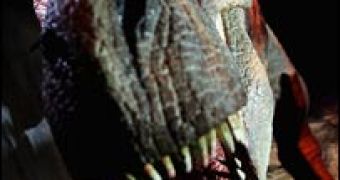Tyrannosaurus rex is one of the largest land predators ever (only a few relatives are even larger) and it's the symbol of ferocious carnivorous beasts. But the image we have about it could be false: it seems that it could not hunt on fast, agile prey.
A US team has made up detailed computer models to find the precise weight and speed of the "tyrant of the dinosaurs." The 6-8 tonnes T. rex seems to have hardly reached 40km/h (25mph) and required a couple of seconds to turn to 45 degrees.
They built on previous work detailing the biomechanics of the famous dinosaur, but added in new refinements.
"We've now got a pretty good estimate of its weight - over which there's been some controversy," said lead author Dr John Hutchinson from Stanford University, California.
"We've shown there's no way it could weigh 3-4 tonnes as some people have suggested. It had to have weighed 6-8 tonnes," he told BBC News.
The computer modeling showed the center of mass position and the inertia (resistance to turning), which determined how the beast moved.
Other studies also determined the body mass and top speed (25-40km/h or 15-25mph), but this is the first calculation of the turning ability of a T. rex. The massive inertia made the dinosaur shift direction incredibly slowly, 1-2 seconds for 45 degrees. The images presenting T-rex and other large related species spinning rapidly on one leg are far from the truth.
Fast moving prey could have escaped easily from the attack of the T. rex. The study constructs a more realistic concept about the large dinosaurs' life.
"These were big clunky things - T. rex and the animals it probably preyed on. We have to slow down our view of that ecosystem," said Hutchinson, currently lecturer in biomechanics at the Royal Veterinary College in the UK.
"It wasn't like the Serengeti today where everything is done at top speed."
"This is another finding that undermines the kind of idea of T. rex as a super-predator. The main reason for that being it was a lot slower than we used to think it was; but it has this huge mouth filled with 60-odd, 30cm-long teeth, so it was still a formidable animal." said Dr Paul Barrett, of London's Natural History Museum.
In fact, this research supports the idea that T-rex was rather a scavenger.

 14 DAY TRIAL //
14 DAY TRIAL //